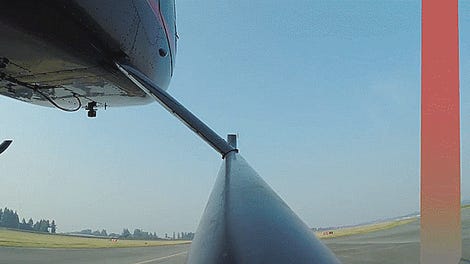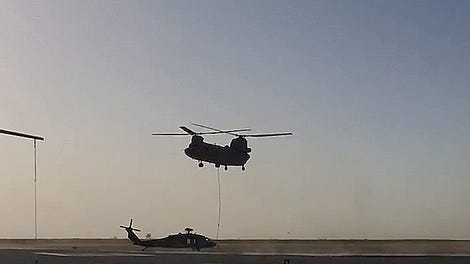This has to be, hands down, one of the weirdest flying machines I’ve ever seen. This is almost certainly some sort of alien craft. This is the Kaman K-Max, and it looks like it’s getting into a flappy hand battle above its own head.
Advertisement
Built to haul huge external loads, up to 6,000 pounds, it’s got two big rotors mounted up top, and they’re synchronized so as to never hit each other. Hopefully. That makes it more of what’s known as a “synchropter” than a traditional helicopter. Apparently the concept has been around for a few decades, with one of the machines even serving in the Vietnam War as the HH-43 Huskie, but I’m just hearing about it now, which makes it Neat.
The K-Max actually went through an initial production run from 1991 to 2003, and the main reason for the weird rotor configuration is that there’s no need for a tail rotor, which saps power that could instead be used for generating vertical lift. Having two main rotors which spin in opposite directions cancels out the need for a tail rotor to push against the torque of one big main rotor, much like you’d see on another heavy-lifting helicopter, the CH-47 Chinook.
Advertisement
But the Chinook isn’t designed specifically as a heavy lifting machine. It’s a huge, multi-purpose helicopter designed for a variety of missions, which helps explain its fore-and aft rotor layout. The K-Max, on the other hand, is designed specifically to carry loads slung underneath it via a long cable, and that necessitates it being small, narrow, and, well, weird, as Flight Global explained way back in 1996:
The petroleum and logging companies can do a lot of damage to the environment, even when using helicopters, for example by cutting out landing pads. The least damaging technique – and also the safest by not requiring the helicopter to land – is to carry everything on the external-load hook. To be even safer and stay above obstructions – primary jungle trees, ships’ aerials, masts and so on, a long line is used between the helicopter’s belly hook and the load. There is another hook on the bottom end. The line may be 25m, 50m or even 70m long. Various techniques have been tried to establish the best method – a talk-down by someone on the ground, or just hand signals; a loadmaster sitting in the back of the helicopter and doing likewise; and the pilot using mirrors, or even a video-screen. All these methods are in use. Indeed, my own experience consisted of a mixture of the above techniques, and all on a much shorter line than that put on by Kaman.
While these techniques may be adequate for short lines, they are inadequate for long ones. The only satisfactory way to extract a log from a forest, place the load exactly into a jungle clearing, or a loaded pallet on to a moving deck without bashing it into the surrounding obstructions is for the pilot to lean out and view what is happening below. The technique is known as “vertical-reference flying”.
Basically, if you’re carrying things on a long line, it helps to have a really narrow helicopter with good visibility. That way, the pilot can peek their head out to see what’s what.
The K-Max got a second lease on life around 2010, when the United States Department of Defense requested two unmanned prototypes for work in Afghanistan to haul loads for Marines. Lockheed Martin even made this terrible video to celebrate that moment:
The two prototypes were shipped off to Afghanistan, where they weren’t expected to do much, being developmental kit and all. But instead of hauling just 6,000 pounds of cargo per day, they ended up hauling 30,000 pounds of cargo per day, as Wired reported, with a 94 percent reliability rate.
Advertisement
Sponsored
It did so well, in fact, that the K-Max started picking up new commercial orders, and the production line was re-started. The first new deliveries are expected this year.
Not bad for a weird looking thing.















